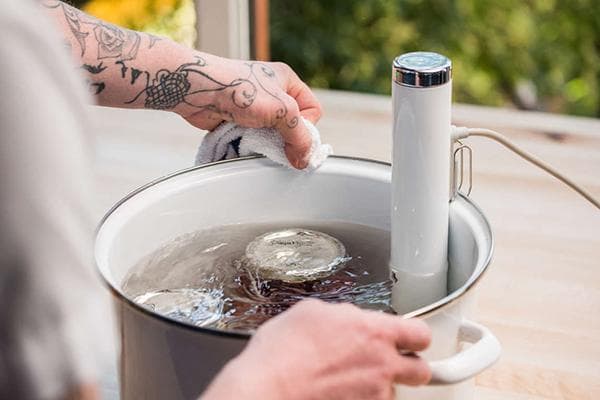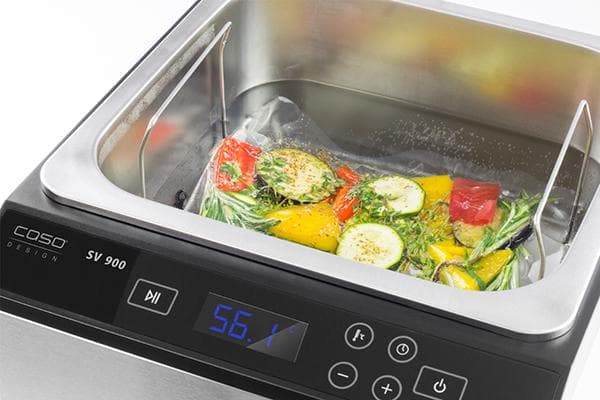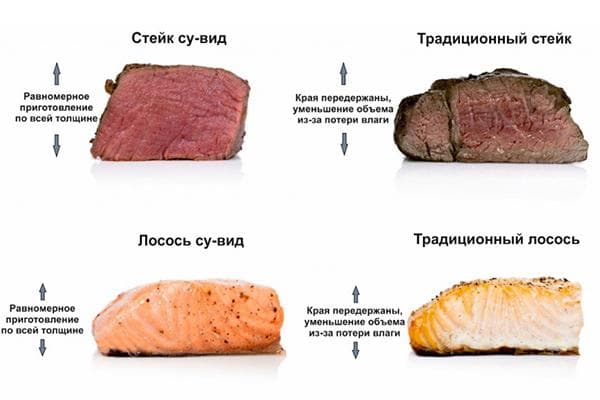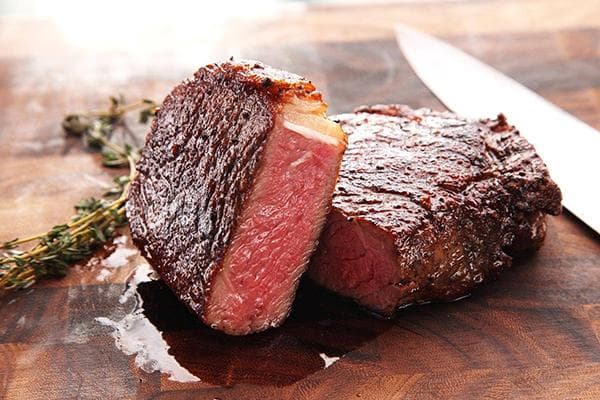Sous vide device - salvation for the “armless”?
Many people have heard about the technology of cooking food in vacuum packaging at a very low temperature - sous vide or sous-vide, which is translated from French as “under vacuum”. In every famous restaurant you can find at least several dishes prepared in this way on the menu. Since the 2010s, sous vide has become increasingly popular. Available devices for home use have appeared. Abroad, almost every family has such a device. But how useful is it and how does it work? Let's figure it out.

Sous vide technology
Sous vide was first used in the restaurant business in the 1970s in France, although its principle was described much earlier, in 1799 by B. Rumfoord. The start to the development of the technology was an order from the head of a fast food chain. It was necessary to make cheap meat tasty and juicy. The goal was achieved using long-term low-temperature heating in the bag.
Sous vide technology has two fundamental points:
- Vacuum shell. Being sealed, the products do not lose their juices. The dishes turn out juicy, tender and well-hydrated.
- Low temperature. Slow heating promotes uniform cooking of the product throughout its thickness.
Many people ask: what about the safety of sous vide food? Although the temperatures used are not high, given the exposure time, this treatment is sufficient to kill the main types of bacteria.Thus, salmonella dies at 65.5 degrees in 30 seconds, and at 54.5 in 15 minutes. In addition, many do not take into account the fact that when frying and boiling, high temperatures only affect the surface of the food. For example, fried meat warms up inside to no more than 60 degrees.
How does sous vide work?
There are two types of devices:
- Stationary. The stationary sous vide is an impressively sized box. It is well insulated, has a built-in heating element, pump, and temperature regulator. Outwardly, it looks like a large multicooker. The downside is that it takes up a lot of space.
- Submersible. Immersion sous vide resembles an “advanced” boiler with a temperature sensor. Instead of a pump, it has a motor for circulating water, as well as a fastening system. The device can be mounted on the edge of a pan or deep food tray, or any other suitable container. However, you will have to take care of thermal insulation and a lid with a hole for sous vide, otherwise the water will quickly boil away.
The principle of operation of both is to uniformly heat water to a precisely specified temperature within 20–100 degrees.
Sous vide works like this:
- The container contains food that has been previously vacuum-packed.
- A saucepan or stationary sous vide is filled with water.
- The desired temperature mode is selected on the instrument panel. Many models are equipped with a timer and delayed start.
- The food is being prepared.
As a rule, the cooking process takes from 30 minutes to 3 hours. But it can also be much longer, up to several days. The advantage is that cooking does not require supervision. You can safely get the product a few hours later. It will not burn or boil over.
The vacuum sealer is not included with the sous vide.It is purchased separately.
What is sous vide used for?
The device opens up new possibilities in home cooking. It allows non-professionals to prepare delicious and healthy dishes at a restaurant level.
Advantages of sous vide:
- Preservation of all vitamins, minerals and other nutrients.
- Maximum natural taste of products.
- Dietary properties. Dishes can be prepared without adding oil.
- Culinary level. A simple piece of meat in sous vide turns out very tasty and juicy without any culinary effort.
- Absence of any odors in the kitchen.
- Cleanliness of the appliance and the kitchen in general.
- Convenient storage. After cooking, food is stored well in a vacuum. Once cooled, they can be frozen and eaten later.
The cooking process in a sous vide device is so simplified that many famous chefs refuse it, citing “lack of spirituality.” When cooking in a frying pan, the cook requires skill and knowledge so as not to spoil the dish. In sous vide, everything is too simple: pack it in a vacuum, turn on the machine - and you don’t even have to really keep track of the time.
Sous vide recipes
There are many recipes for sous vide. All of them are simple to the point of impossibility. You simply place the product you want in a plastic bag, pump out the air, and set the correct temperature and time. The settings depend on the size and type of product, as well as the desired degree of doneness.
There are special tables for sous vide:
Recipes:
-
- Classic steak. Place a beef fillet weighing 450 g (optimally striploin) into a vacuum package. Set the temperature to 54 degrees. Cook for 45 minutes. Remove the steak from the packaging and lightly fry in a frying pan with 50 g of butter and 0.5 teaspoon of thyme.
- Creamy potatoes. Peel 400 g of new potatoes. You can take a regular one, but then each tuber should be cut into 4 parts. Mix potatoes with 1 tbsp. a spoonful of salt, 1 teaspoon of black pepper, 2 teaspoons of rosemary or thyme. Add 1 tbsp. a spoonful of vegetable oil and 2 tablespoons of butter. Seal everything in a vacuum bag. Cook for 1 hour at 87 degrees.
- Lemon cod. Clean 2 cod fillets and season with salt and black pepper to taste. Sprinkle with juice of 1 lemon. Grate the zest and sprinkle it over the fish to taste. Place the fillet in a plastic bag and add 1 tbsp. spoon of olive oil. Pump out the air. Heat sous vide to 55 degrees. Cook for 30 minutes.
Whether to buy sous vide for your home or not is an individual question. Many adherents of healthy and as natural food as possible are delighted with it. But if you like dishes with a golden crust, you need to keep in mind that when cooking in a vacuum it does not form. The product will have to be fried additionally. If in doubt, try making the dish sous vide in a slow cooker using cling film. Many models are capable of maintaining low temperatures. However, keep in mind that the effect will be similar, but not exactly the same. In professional appliances, products are cooked perfectly thanks to water circulation and high accuracy of the temperature sensor.







Provide links to source materials!